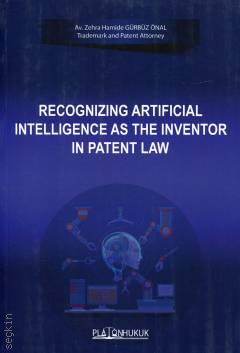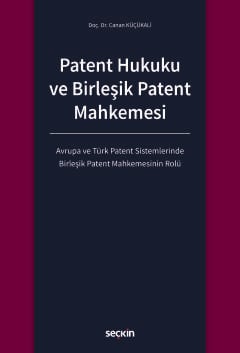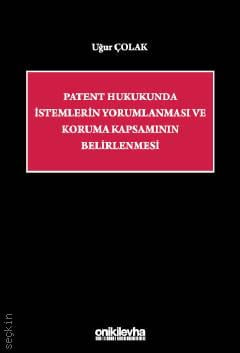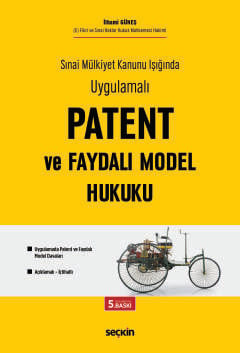>
Hukuk Kitapları>
Fikri-Sınai Mülkiyet Huk.>
Sınai Mülkiyet HukukuPatent>
Recognizing Artificial Intelligence as The Inventor in Patent Law

Recognizing Artificial Intelligence as The Inventor in Patent Law
1. Baskı,
Mayıs 2025
Kitabın Detayları
Dili:
Türkçe
Ebat:
16x24
Sayfa Sayısı:
150
Kitabın Fiyatı:
340,00₺
Temin süresi 2-3 gündür.
Kitabın Açıklaması
This book not only analyzes judicial decisions but also offers essential background for understanding the topic: What exactly is artificial intelligence? What is machine learning? Why has the debate around AI inventorship become so intense, and how have media narratives and commercial interests amplified it?
As Andrew Ng has noted, AI is becoming a transformative, general-purpose technology — "the new electricity." Yet the author argues that AI, for now and the foreseeable future, remains a sophisticated tool rather than a source of independent creativity. The legal system must assess AI's role thoughtfully, without attributing human qualitiesoverstating its capabilities.
This book is an essential read for legal professionals, technologists, and anyone interested in the intersection of law and emerging technologies. With clarity and depth, it invites readers to consider where AI fits within the innovation ecosystem — and where it does not.
Kitapla İlgili Kategoriler
Kitabın İçindekileri
TABLE OF CONTENTS
LIST OF ABBREVIATIONS 9
INTRODUCTION . 11
CHAPTER ONE
ARTIFICIAL INTELLIGENCE (AI)
CHRONOLOGICAL OVERVIEW OF AI. 15
A) The History That Builds and Defines AI . 15
Understanding AI: Algorithm 22
Definition of AI 27
Human Intelligence and Machine Intelligence . 32
B) Machine Learning (ML) 35
Definition of ML 35
Types of ML . 38
Supervised Learning (SL) 38
Unsupervised Learning (USL) . 38
Reinforced Learning (RL) 39
Deep Learning (DL) . 40
Artificial Neural Networks (ANN) 41
Examples of DL . 42
Evolutionary Computing (Programming) 42
AI TODAY 45
A) Artificial Narrow Intelligence (ANI) 45
B) The Benefits of ANI 47
III. FUTURE OF AI 47
A) Artificial General Intelligence (AGI) 47
B) Artificial Super Intelligence (ASI) 50
CHAPTER TWO
RELAVANT CONCEPTS IN PATENT LAW AND PATENTABILITY OF AI SYSTEMS AND INVENTIONS OVERVIEW OF PATENT LAW 51
A) Etymology and History . 52
Turkish Patent Law 53
History of Turkish Patent Law . 53
The Recent Law . 54
International Legislation 54
B) Invention and Inventor . 55
Invention . 55
Invention in Turkish Law . 55
Invention in Europe and Other Jurisdictions . 57
Inventor 57
Inventor in Turkish Law . 58
Inventor in Europe and Other Jurisdictions . 59
C) Patentability Criteria 60
Novelty . 61
“State of Art” in Novelty 61
Explanation of Novelty with an Example 63
Inventive Step (Non–Obviousness) 65
“State of Art” in Inventive Step . 66
Exceptions of “State of Art” inuating Inventive Step 66
First Exception: Unpublished Patent Applications 66
Second Exception: The Related Area 67
Expert in the Field . 67
Determining the Inventive Step: “Problem–Solution” Approach . 67
Industrial Applicability 69
PATENTABILITY OF AI SYSTEMS AND AI INVENTIONS . 70
A) Patentability of Computer Software 71
B) Patentability of AI Systems . 73
C) Patentability of AI Inventions 74
Disclosure of AI . 74
Global Cooperation on AI 75
Inventorship of AI 75
Patent Law Term “The Skilled Person” and AI . 75
CHAPTER THREE
AI AS AN INVENTOR RECENT ADVANCEMENT of AI APPLICATIONS in DIFFERENT SECTORS . 77
RECOGNIZING AI: DIFFERENT APROACHES FOR PERSONALITY . 79
A) Electronic Personality 80
B) Attorney/Representative Approach . 81
C) Artificial Human Approach . 82
D) Slavery Approach 82
III. THE DABUS CASE: THE EARLY CROWING ROOSTER 83
A) What Is DABUS? 84
B) The Artificial Inventor Project (AIP) 87
C) DABUS Patent Applications . 88
D) Rejection of DABUS Patent Applications 94
Decision in UK on DABUS Application . 94
Decision of EPO on DABUS Application . 96
Decision in US on DABUS Application 97
Other PCT Countries: Australia, Germany, South Africa 100
Decision in Australia on DABUS Application 102
Decision in Germany on DABUS Application 103
Decision in South Africa on DABUS Application 104
CHAPTER FOUR
FUTURE OF PATENT LAW REGARDING AI FUTURE OF PATENT LAW 105
A) Can AI Be Recognized As Inventor 106
Arguments of the Positive Perspective . 108
Argument One: Current System Discourage Honesty . 109
Argument Two: Incentivise Innovation . 110
Argument Three: Reform in Patent Law Is
Indispensable . 110
Argument Four: Society Will Be the Owner of the
Invention 110
Arguments of the Negative Perspective . 111
Argument One: Opponents of IPR Protection . 111
Argument Two: Opponents of Pre–acceptance 111
Argument Three: Inventiveness is Unique to Human
Being 112
B) Can AI Invent? . 112
C) About the AI Inventions Cited in the Literature 114
Circuit Designs By John Koza’s “Invention Machine” . 114
“Oral–B Cross Action Tooth Brush” by “Creativity
Machine” 115
“Food Receipt” By Contest Winner Watson’s Jeopardy . 115
“Nose Cone” by Hitachi Company 116
“Fractal Food Container” and “Devices and Methods for
Attracting Enhanced Attention” by DABUS . 116
The NASA Antenna . 116
“Digital Twin” Car Suspension by Siemens 117
Robot Eve in Medical Field . 117
D) Anthropomorphism in AI 118
CONCLUSION . 121
ABSTRACT . 125
ÖZET . 127
BIBLIOGRAPHY . 129
LINKS 148
LIST OF FIGURES 150
Kitabın Fiyatı:
340,00₺
Temin süresi 2-3 gündür.
Bu kitaplar da ilginizi çekebilir
Hakkımızda
|
Uluslararası Yayınevi Belgesi|
Kaynakça Dosyası|
Kişisel Verilerin Korunması |
Üyelik|
Siparişlerim|
İade Politikası|
İletişim


